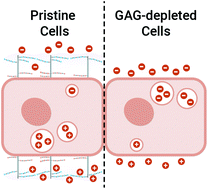Cell-surface glycosaminoglycans regulate the cellular uptake of charged polystyrene nanoparticles†
Abstract
Engineered nanoparticles approaching the cell body will first encounter and interact with cell-surface glycosaminoglycans (GAGs) before reaching the plasma membrane and becoming internalized. However, how surface GAGs may regulate the cellular entry of nanoparticles remains poorly understood. Herein, it is shown that the surface GAGs of Chinese hamster ovary cells perform as a charge-based barrier against the cellular internalization of anionic polystyrene nanoparticles (PS NPs). In contrast, cationic PS NPs interact favorably with the surface GAGs and thereby are efficiently internalized. Anionic PS NPs eventually reaching the plasma membrane bind to scavenger receptors and are endocytosed by clathrin-mediated and lipid raft/cholesterol-dependent mechanisms, whereas cationic PS NPs are primarily internalized via clathrin-mediated endocytosis and macropinocytosis. Upon the enzymatic shedding of surface GAGs, the uptake of anionic PS NPs increases while that of cationic PS NPs is dramatically reduced. Interestingly, the diminished uptake of cationic PS NPs is observed only when heparan sulfate, but not chondroitin sulfate, is cleaved from the cell surface. Heparan sulfate therefore serves as anchors/first receptors to facilitate the cellular entry of cationic PS NPs. These findings contribute to advance the basic science of nanoparticle endocytosis while also having important implications for the use of engineered nanocarriers as intracellular drug-delivery systems.



 Please wait while we load your content...
Please wait while we load your content...